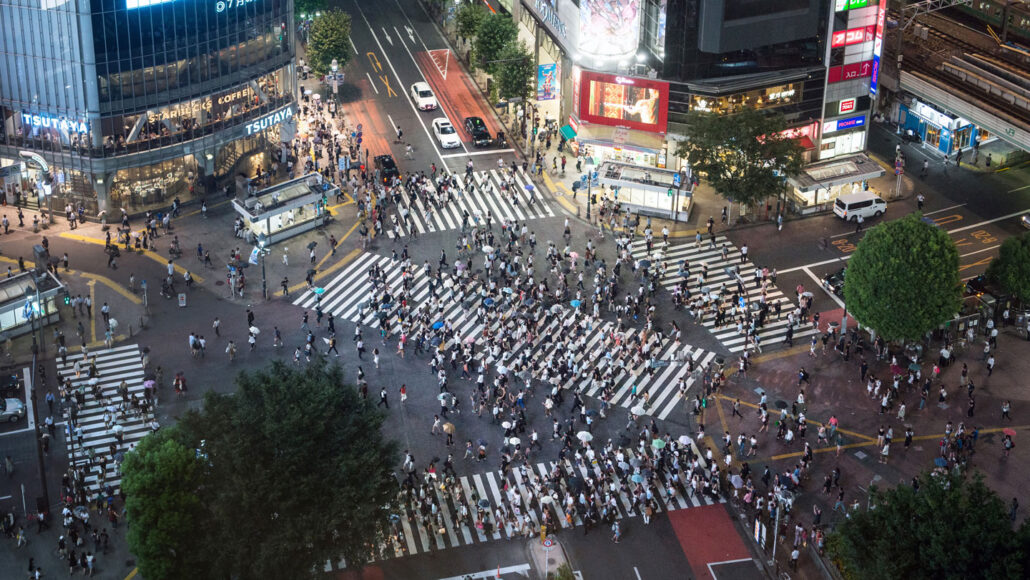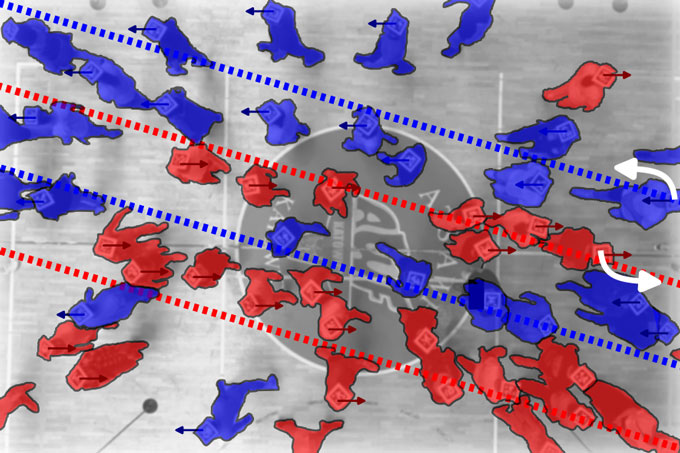Math explains why dense crowds form surprisingly orderly lines
Research on lane formation reveals more about how crowds of people move

Scientists know that pedestrians heading in opposite directions will form multiple parallel lines at big intersections. The photo shows Shibuya Crossing in Tokyo, Japan.
Noppawat Tom Charoensinphon/Moment/Getty Images Plus
Share this:
- Share via email (Opens in new window) Email
- Click to share on Facebook (Opens in new window) Facebook
- Click to share on X (Opens in new window) X
- Click to share on Pinterest (Opens in new window) Pinterest
- Click to share on Reddit (Opens in new window) Reddit
- Share to Google Classroom (Opens in new window) Google Classroom
- Click to print (Opens in new window) Print
The hallway between classes may seem chaotic. But there’s likely more order than you think in the crowd.
If you’ve ever moved in a heavy crowd with people going in opposite directions, you may have noticed a pattern. People tend to sort themselves into multiple lanes that run parallel to each other. In a study, researchers used a computer to model how those lanes form and shift. They found that people fall into a natural flow without the need for directions.
The mathematical model was made by Tim Rogers and Karol Bacik. Rogers and Bacik are mathematicians at the University of Bath in England. If a space is wide enough, the model shows, two groups of people passing each other head-on will form multiple lanes. Each lane will be about the width of two people.
If the two groups cross paths at right angles, they still form lanes. But these lanes behave a little differently. Each person stays in their lane, but the lane as a whole will shift to the side as the groups cross. And attempts to direct the crowd may not help. Tell everyone to pass on the right, for example, and it will mess up this natural flow. This slows everybody down. Rogers and Bacik reported these results March 3 in Science.
As it turns out, the best thing you can do to control the traffic is … nothing at all. “Anarchy is enough,” Rogers says.
Model students
Rogers and Bacik began working on crowds early during the COVID-19 pandemic. At that time, there were barely any crowds at all. But the researchers were working to design spaces where people could stay socially distanced to prevent viral spread. For example, how can you allow a large volume of people to pass through an area quickly while staying two meters (six feet) apart?
The team started with existing software. Decades ago, Dirk Helbing also modeled pedestrian traffic. Helbing is a physicist at ETH Zürich in Switzerland. He created a mathematical model to explain why lanes form when two groups move in opposite directions. His model describes the direction a pedestrian plans to go. It also predicts how a person will change their movement so they won’t collide with another person. Helbing called these reasons for lane formation in a crowd “social forces.”
This model was part of the software Rogers and Bacik used while designing socially distanced spaces. But it’s still a challenge to bridge the gap between one person’s choices and the patterns of the crowd. Bacik and Rogers wanted to account for both. They suspected that multiple factors are all “different parts of the big picture,” Bacik says.

Rogers and Bacik’s model describes lane formation as a result of two processes. The first process is drift. Think back to that crowded school hallway. As students try to get to a specific door, they can drift from their planned route. This might be to avoid collisions with people going the opposite way. Or they may choose to go toward pockets where there are fewer people. This drift strongly encourages lane formation. As soon as a stripe of people headed one way starts to form, others going the same way are drawn to it. People headed the other way are pushed away, into their own lane.
The second process is diffusion. Diffusion causes pedestrians to spread out. This way, not all the people moving in one direction get concentrated in one place.
In general, drift encourages lane formation. Diffusion tends to erase lanes unless they are wide enough. Rogers and Bacik wanted to figure out which process dominates in a crowd. To do so, they used a technique called perturbation analysis. It showed that lanes on the scale of two body widths are just the right size to resist diffusion. “It’s a great idea, and I wish I had thought of it myself,” says Nicolas Bain. Bain has studied lane formation as a student at École Normale Supérieure in Lyon, France. He was not involved in the research.
Rogers and Bacik also tested what would happen to two streams of people crossing in a square room when one or both streams have to funnel through a narrow exit, such as a doorway. Here, a surprise emerged: The lanes that form are curved. If one exit is narrow, the lanes make the shape of a parabola. If both exits are narrow, the lanes form an ellipse. No one studying lane formation in the past 30 years had seen this before.
Real-world crowds
The team then tested these mathematical predictions in a real crowd of people. First, the researchers set up a 6-meter-by-6-meter arena in Katowice, Poland. (That’s about 20 feet by 20 feet.) Then they had a crowd of 60 to 70 people pass through the space while they were filmed. The video footage confirmed the model’s predictions. People consistently ordered themselves into lanes as expected. The fact that the experiments match the model predictions “makes the paper top-notch,” says Hartmut Löwen. A physicist at the University of Düsseldorf in Germany, he was not involved in the research.
Rogers and Bacik’s recent work shows the positive side of crowd behavior. But pedestrian flow can cause dangerous and sometimes tragic situations. Stampedes or crowd crushes have killed people. More than 150 people celebrating Halloween in Seoul, South Korea, in 2022 died in a crowd crush, for example. And in Saudi Arabia in 2015, hundreds of pilgrims in a crowd traveling to Mecca were crushed to death. Public spaces can be designed to help prevent such tragedies.
According to Helbing, one sign of trouble is three-way (or more) collisions. In these instances, people have no good way to escape, and they get stuck. Such collisions are more common at Y-shaped or four-way intersections. Rogers and Bacik specifically excluded such situations from their models. Civil engineers would be well advised to avoid them, too.
Two streams of pedestrians can cross in a “surprisingly efficient way,” Helbing says. But when more streams are involved, the movement becomes unstable. This can lead to “crowdquakes,” in which people can’t control where they are going. The takeaway: When pedestrians are traveling two ways, trust the wisdom of crowds. When there’s a three-way or four-way intersection, watch out.







